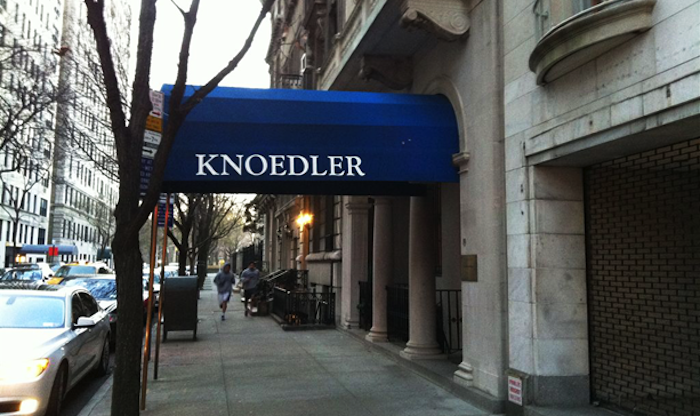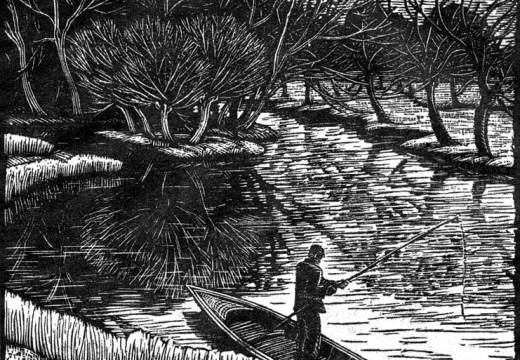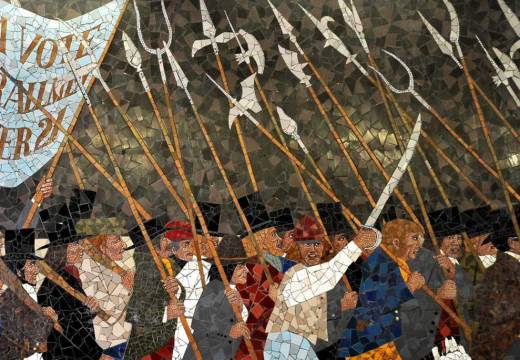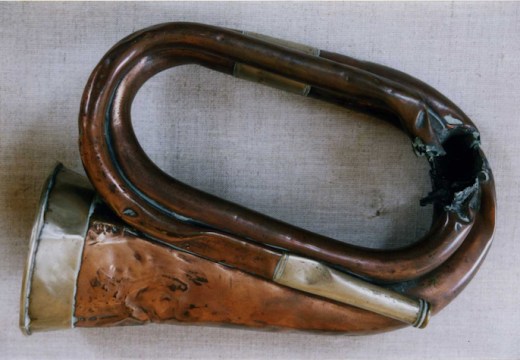On 30 November 2011, the Knoedler Gallery in New York closed its doors, bringing trading to a close after 165 years. It had been one of the oldest and most established galleries in America. Most major museums in the country own work that has, at some stage, passed through its agents’ hands, and many of the most esteemed private collections were gathered under their watch. Although the gallery announced that the move was a ‘business decision made after careful consideration over the course of an extended period of time’, there had been no obvious indication that business had been suffering. The gallery’s impromptu, unannounced closure was a surprise to most, and an indication of something far more serious.
The previous day, Pierre Lagrange, a London-based hedge-fund manager, had presented the gallery with a dossier of independent research on a Jackson Pollock painting he had bought from Knoedler in 2007 for $17 million. The research alleged that the painting was a fake – forensic tests had revealed pigment not available until many years after Pollock’s death. Lagrange gave the gallery 48 hours to reimburse him or face being sued. The gallery refused, closed, and received a lawsuit from Lagrange the very next day.
In the media furore that followed, it transpired that Knoedler had been the victim of one of the most extreme incidences of art fraud ever to come to light. From the early 1990s the gallery sold 63 paintings that had been consigned to them, one at a time, by an obscure art dealer called Glafira Rosales. The group included works purportedly by some of the best known, commercially lucrative, abstract expressionists – Mark Rothko, Robert Motherwell, Willem de Kooning, Barnett Newman – ‘A treasure trove of paintings’ as Ann Freedman, the former gallery director who sold the majority, has called them. Last year the Federal Government found Rosales guilty of fraud. An FBI investigation had revealed that she had been paying Chinese-American Pei-Shen Qian to create the works in a garage in Queens. Rosales had made $30 million over the years, the gallery far more. It is believed that collectively, the paintings sold for a total of $80 million.
The revelation has sent shivers through the art world; not just because of the extent of the humiliation and financial damage to a respected establishment and its collectors, but also because of the unwelcome light that the ensuing, ever mounting lawsuits and media attention have cast on some of its less transparent areas. The quest for compensation and probing legal investigations into how fraud of this magnitude could have happened has exposed the processes behind art sales, forcing the thorny issue of what should be the reasonable and reasoned business of authentication and attribution into the spotlight.
The market can be the strictest judge of all, and dealers have developed ways to reassure buyers and protect themselves against errors. 2013, the year in which Rosales was convicted, was also the year in which prices for post-war and contemporary art broke multiple records, prompting the art market correspondent for the Financial Times to predict in her end of year summary that ‘Provenance, now, is going to be far more important’. An unbroken chain of provenance is the simplest, most traditional way to verify an artwork’s authenticity. But, as the art historian Bendor Grosvenor tells me: ‘Absolutely certain, provable, complete provenance is very rare indeed.’ Complicating matters further, provenances are often kept deliberately obscure for many reasons that are often favourable to both seller and dealer and ‘Private collection’ is ubiquitous within cataloguing practice. When Rosales would reveal no more about the origin of the pictures than the fact they had passed by descent from ‘Mr X’, who had apparently obtained them direct from the artists’ studios, to ‘Mr X, Jr.’, Freedman deemed it credible. Her clients then trusted that she knew the consigner.
Auction houses in particular, whose relentless calendar of sales might otherwise compromise a process of in-depth research on every work, have set in place a strict protocol for consignments. ‘It is about trust, definitely,’ Dirk Boll, managing director of Christie’s for continental Europe, tells me. He admits this is an advantage for a large organisation such as Christie’s. ‘You cannot have the whole process in one hand, where someone gets business in one hand and sells to someone else without any correction and control in the middle’. The reassurance of the brand is key – as is the ‘large warranty that these bigger businesses are able to supply’, he adds. Lagrange’s suspicions were first aroused, for instance, when both Christie’s and Sotheby’s refused to resell his Pollock because the work was not in the artist’s catalogue raisonné. It had therefore failed the first step in the process of due diligence that both houses undertake for every lot in their sales. Further stages include checking wider literature on the artist and tracing the work’s exhibition history. Finally, the relevant department will try to confirm the details of the work with the ‘expertise’ – generally, for contemporary art the artist themselves, their studio or gallery; for modern and post-war art their estate or foundation; and for older works, the leading scholars. If the work dates to before 1945, it must go via the company’s dedicated restitution department.
However, recent years have seen many of these expert sources become increasingly wary of assisting in authentication processes, something that can be equated directly with the pressure of market value and the difficulties inherent in the process. A vital part of Knoedler’s defence – the gallery is facing 10 lawsuits – is that a number of experts had seen the works and had not openly disputed their authenticity. Freedman appears to have taken their silence for consent, saying in an interview with New York Magazine ‘if something had been off or wrong on any of the paintings, I would have put on the brakes’. Silence avoids the risk of being sued for negligence, defamation or fraud, which – even if experts were to prevail – might incur considerable financial and reputational damage. Receiving a fee for their opinion, meanwhile, could be criticised for presenting a conflict of interest and undermine the credibility of an expert in a case, and would be minimal recompense if faced with a lawsuit. In April a lawsuit was filed against a former curator at the Beyeler Foundation in Switzerland for knowingly participating in the Knoedler fraud ‘either intentionally or with wilful blindness or reckless disregard for the truth’ – on the grounds that he was paid a $300,000 consulting fee by Knoedler to help sell a $7.2 million ‘Rothko’, and that he received $150,000 from the buyer.
Many museums now actively discourage their staff from authenticating works on behalf of anyone else, and, perhaps most visibly, a number of artist foundations in America have refused to continue to help authenticate works. A few of the most high-profile cessations include the Pollock-Krasner Foundation in 1996; the Roy Lichtenstein Foundation and Andy Warhol Foundation in 2011; and the Keith Haring Foundation and the Estate of Jean-Michel Basquiat in 2012. Despite frequently defending themselves successfully against disgruntled collectors with work that they have rejected, each cited the money and time spent on battling these cases as the main reasons for ceasing authentication activities.
Yet such foundations can play an important role in the authentication procedure, bringing together trusted authorities and comprehensive archival resources to provide informed, impartial decisions that have the potential to generate – or lose – somebody a substantial amount of money. The misgivings that the Dedalus Foundation, specialising in the work of the artist Robert Motherwell, had about the art produced by Rosales led to further investigations that were instrumental in her unravelling. The president of the foundation, Jack Flam, had simply made inquires with the Richard Diebenkorn estate, the Willem de Kooning Foundation and the Barnett Newman Foundation, and discovered that they had also had their doubts about the Knoedler cache.
But it is rare to find an artist with an entirely comprehensive archive or cataloguing process, and even with forensic tests, attribution decisions can still come down to a matter of opinion. Connoisseurship, which is a judgement of the eye based largely on experience and instinct, has always played a vital role. Until the advent of forensic technology, this intuitive process based on physical observations was often the main way in which paintings were identified. This is still the case in the trade of Old Master paintings, where provenances are more difficult to trace. ‘For me,’ Grosvenor says, ‘connoisseurship is by far the most important factor, usually because it’s rare to be able to find documentary proof in the form of provenance going all the way back to an artist. Equally, forensic research is often hailed as a magic bullet when it comes to proving attribution, but the reality is that it isn’t.’ This may be because technical analysis in itself is not straightforward, and can be inter- preted differently by experts within that field.
Connoisseurship, scientific analysis and historical research are all useful within the authentication process; it is difficult to standardise, and as a result there are no universal procedures from which to judge what is negligent practice. To a significant extent, the practice of all art professionals – dealers, auction houses, and scholars – is regulated by competition. As Boll says, ‘It’s very simple. We work with all the information we can get. We do whatever is necessary to meet the standards of our business and our company.’ Although few would deny that a growing, wider culture of litigation has affected the art market in recent years, relative to the number of transactions that occur daily in the art world, the number of lawsuits involving authentication, attribution or authorship issues, is low. And the law in these cases, which the layperson might presume to be black and white, has to accommodate for standards that come in many shades of grey.
The handful of cases in England that have reached trial stage reflect this. In 1990, in the case Luxmoore-May v. Messenger May Baverstock, a regional auctioneer successfully appealed against a decision that it had been negligent in not attributing a painting to Stubbs. The judge stressed that ‘valuation of pictures, of which the artist is unknown, pre-eminently involves an exercise of opinion and judgement…which may be fallible’, cautioning against the influence of hindsight. In 2005, although the court agreed with the claimant that a pair of vases were worth far more than a Christie’s catalogue valuation, it found that the auction house had not been negligent, and were reasonably entitled to their view. Recently however, accusations of negligence and misrepresentation brought by Avrora Fine Arts Investment against Christie’s were dismissed, but Christie’s were still made to reimburse the buyer the full amount paid for a painting that had been attributed to the Russian artist Boris Kustodiev under their warranty. Whether or not the painting was genuine was still a principle issue: deemed to be something that could only be determined by ‘an expert’s eye’, the court made its decision based on how convincing the expertise presented by each side was.
Many disputes are settled outside the courts, including one of the most prominent cases in England in recent years where Christie’s was sued for breach of duty and/or negligence in relation to Titian’s Salome with the Head of John the Baptist which was sold for £8,000 as Studio of Titian but was later valued at $4-6million. Solicitors from the art law specialists Boodle Hatfield, who represented the claimant, confirmed that the details of the final settlement were confidential, but that if these cases do not reach the courts, further clarification of the law within this field is prevented.
In the wake of the Knoedler scandal, more is being done in America to protect experts. This March a bill was presented to the New York State Legislature and New York Senate to incentivise ‘authenticators’, those recognised as having expertise regarding an artist or work of fine art or those who are able to provide evidence that serves as a direct basis for an authenticity opinion, such as forensic scientists. Acknowledging the role of authenticity as an influential factor in the art market, the bill expressly excludes anyone with a financial interest in the work of fine art being evaluated, other than being compensated for providing an opinion. By tipping the balance of proof towards the claimant, so that a claim reaches court only if there is clear and convincing evidence, and by requiring that the authenticator’s legal fees are paid if they defend themselves successfully, it is hoped that experts will be protected – in the words of Senator Betty Little, who presented the Bill – ‘from frivolous legal action while still holding them accountable for wrongful actions.’ Meanwhile in France, where the courts can compel an expert to change their opinion, the Cour de Cassation recently ruled in favour of the author of the Jean Metzinger catalogue raisonné, recognising that her refusal to authenticate a painting was a result of her ‘intimate conviction’; to force her to change it would be a breach of her right to freedom of expression under the European Convention of Human Rights.
It is natural that buyers and dealers looking for a sound investment or risk free purchase would favour artists whose works have been comprehensively catalogued. Christophe Van de Weghe, a New York art dealer, told The Economist that if a good new catalogue raisonné of Modigliani drawings were published, sales worldwide would rise
by about a fifth. Of Gerhard Richter, who is meticulous about how his works are catalogued, dealer Kenny Schachter has said: ‘Richter’s market surely benefits from such unequivocal certainty with regard to his output, I’d say to the tune of a 20% kicker.’ But this attitude reflects a more general trend, within the trade, towards art being appreciated primarily as a commodity, rather than a matter of taste or connoisseurship. It is important that authenticators are not made immune from liability, especially given the complexities involved in the authentication process and rising financial stakes. But if opinion becomes stagnant, quite simply it could encourage familiarity over discovery, and living artists over the dead. Promoting diligent scholarship, vigilant, responsible buying and free, robust exchanges of opinion could have important repercussions that extend beyond forged works being absorbed into the market.
Click here to buy the October issue of Apollo
Elsewhere on the web
‘Document dump’ reveals new details in Knoedler case (The Art Newspaper)
Unlimited access from just $16 every 3 months
Subscribe to get unlimited and exclusive access to the top art stories, interviews and exhibition reviews.














![Masterpiece [Re]discovery 2022. Photo: Ben Fisher Photography, courtesy of Masterpiece London](http://www.apollo-magazine.com/wp-content/uploads/2022/07/MPL2022_4263.jpg)
Why are fathers so absent from art history?